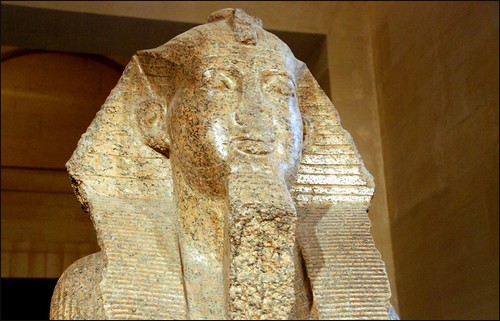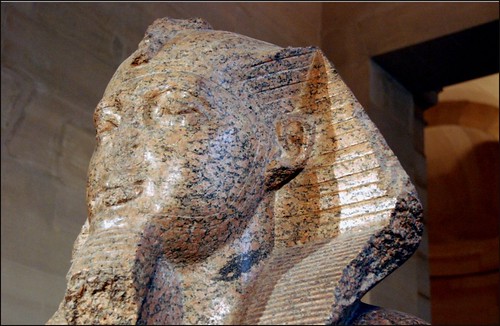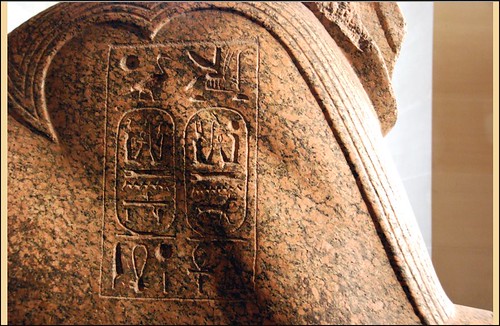Jutauyra
De Wikipedia, la enciclopedia libre
Sejemra Jutauy Sebekhotep, o Jutauyra, fue el primer faraón de la dinastía XIII de Egipto, gobernando c. de 1759 a 1757 a. C. (Franke).
Reinó unos dos años y la capital estaba en El-Lisht. Ryholt cree que Sejemra Jutauy Sebekhotep era hijo del faraón Amenemhat IV.
El primer faraón de la dinastía está inscrito en el registro VI,5 del Canon Real de Turín, como ...ra Jutauy, con dos años, tres meses y 24 días de reinado. Fue confundido con Sejemra Jutauy Amenemhat Sebekhotep Ugaf (Sebekhotep II), pero varios descubrimientos arqueológicos han comprobado que era un error debido a la similitud de los nombres de trono (Kim Ryholt).
Su nombre de Horus fue Sejem Necheru "El dominio de los dioses"; su nombre de Nebty fue Jabau "el poder se manifiesta", su nombre de Horus de oro fue Merytauy, "El que ama las Dos Tierras"; su nombre de Trono Sejemra Jutauy, "Poderoso Ra, protector de las Dos Tierras".
Contenido |
Testimonios de su época [editar]
Se ha encontrado varios objetos e inscripciones con su nombre:
- en el templo de Montu en Medamud,[1]
- una estela, encontrada en Karnak,
- una estela, en la Baja Nubia,
- una estatua que se encuentra en el museo de Jartum,
- una estatua, que posiblemente representa a Jutauyra, en el Museo Egipcio de El Cairo,
- dintel Deir el-Bahari,[2]
- un escarabeo con su título,
- papiro de Kahun (Museo Petrie UC32166),
- cuenta (Museo Petrie UC13202)
Unas inscripciones de nilómetro, en Semna y Kumma, proporcionan la fecha del 4º año de su reinado.[3]
Titulatura [editar]
| Titulatura | Jeroglífico | Transliteración (transcripción) - traducción - (procedencia) |
| Nombre de Horus: |
| sḫm nṯr.u (Sejem Necheru) El dominio de los dioses |
| Nombre de Nebty: |
| ḫˁ b3.u (Jabau) El poder se manifiesta |
| Nombre de Hor-Nub: |
| mry t3uy (Merytauy) El que ama las Dos Tierras (Egipto) |
| Nombre de Nesut-Bity: |
| sḫm rˁ ḫu t3uy (Sejemra Jutauy) Poderoso Ra, protector las Dos Tierras |
| Nombre de Sa-Ra: |
| sbk ḥtp (Sebek Hotep) Sobek está satisfecho |
| Nombre de Sa-Ra: |
| u g 3 f (Ugaf) (?) Ugaf (?) |
Referencias [editar]
- Referencias digitales
- http://www.digitalegypt.ucl.ac.uk//chronology/2interkings/sobkhotepI.html (en inglés)
- http://www.narmer.pl/dyn/13en.htm (en inglés)
Bibliografía [editar]
- K.S.B. Ryholt, The Political Situation in Egypt during the Second Intermediate PeriodCarsten Niebuhr Institute Publications, vol. 20. Copenhagen: Museum Tusculanum Press, 1997). (
| Predecesor: Neferusobek | Faraón Dinastía XIII | Sucesor: Amenemhat Sonbef |
Wegaf
From Wikipedia, the free encyclopedia
| Wegaf | ||||
|---|---|---|---|---|
| Ugaf | ||||
| Pharaoh of Egypt | ||||
| Reign | 1632 BC?, 13th Dynasty | |||
| Predecessor | Unknown | |||
| Successor | Unknown | |||
Khutawyre Wegaf (or Ugaf) was an Egyptian king of the 13th Dynasty who is known from several sources, including a stelae and statues. There is a general known from a scarab with the same name (Wegaf) who is perhaps identical with this king.
A king with the name Khutawyre appears in the Turin King List as first ruler of the 13th Dynasty. However, some researchers especially Kim Ryholt argue that the writer of the King list confused the name Khutawre with the name Sekhemre-Khutawy and they place Wegaf in the middle of the 13th Dynasty. Sekhemre Khutawy is regarded by Kim Ryholt as the son of Amenemhet IV but this idea is not currently accepted by most Egyptologists..
[edit] See also
[edit] References
- K.S.B. Ryholt, The Political Situation in Egypt during the Second Intermediate PeriodCarsten Niebuhr Institute Publications, vol. 20. Copenhagen: Museum Tusculanum Press, 1997). (
related articles
- Sobekhotep II
- Sobekneferu
- Ankhu
- Neferhotep I
- Timeline of ancient country changes
- Amenemhat IV
- Sedjefakare
- El-Lahun
- Khendjer
- Timeline of country and capital changes
En otros idiomas
- العربية
- Català
- Deutsch
- English
- Euskara
- Suomi
- Français
- Italiano
- Nederlands
- Română
- Русский
- Srpskohrvatski / Српскохрватски

Cargado el 1 de febrero, 2009
Galería de Hans Ollermann
King Ramses II (also called Ramses the Great) 1279-1212 B.C.

Great temple of Ramses II.
Comentarios
Hans Ollermann  says:
says:
Quite so, Lenka. Publicado hace 13 meses.
2008_1112_135958AA Musée du Louvre, Paris

ca. 1750 B.C.
From Tanis.
Granite.
5 centuries later King Ramses II and Merenptah put their names on it.
Musée du Louvre, Paris.
2008_1112_140035AA Musée du Louvre, Paris

ca. 1750 B.C.
From Tanis.
Granite.
5 centuries later King Ramses II and Merenptah put their names on it.
Musée du Louvre, Paris.
2008_1112_140010AA Musée du Louvre, Paris

ca. 1750 B.C.
From Tanis.
Granite.
5 centuries later King Ramses II and Merenptah put their names on it.
Musée du Louvre, Paris.
2008_1112_140021AA Musée du Louvre, Paris

ca. 1750 B.C.
From Tanis.
Granite.
5 centuries later King Ramses II and Merenptah put their names on it.
Musée du Louvre, Paris.
2008_1217_135001AA Musée du Louvre, Paris

Prince Khâemouaset
(Chaemwese), son of Pharaoh Ramses II.
Discovered in 1851-1853 by Mariette in the Serapeum.
1280-1215 B.C.
Reign of Ramses II.
Musée du Louvre, Paris.
See also my list of best and worst museums in the world:
www.flickr.com/photos/menesje/4059308291/
And here you find my list of best and worst museums in Holland:
www.flickr.com/photos/menesje/4059604700/
Comentarios
Su55  says:
says:
Exquisite Hans!
Publicado hace 14 meses. ( enlace permanente )
pyramidtextsonline  says:
says:
Wow, that is beautiful.
Publicado hace 14 meses. ( enlace permanente )
melanotheos [eliminado] dice:
Prince khaumwaset who was high-priest of ptah in memphis, much later on became the figure of the fictional prince khaumwas who discovers the secret book of thoth in the late period demotic story setne published by frances griffith.
Publicado hace 14 meses. ( enlace permanente )
Yinon.P. says:
Hi, I'm an admin for a group called Ancient Egyptian Jewellery, and we'd love to have this added to the group!Publicado hace 4 semanas.
2008_1217_134536AA Musée du Louvre, Paris

Prince Khâemouaset
(Chaemwese), son of Pharaoh Ramses II.
Discovered in 1851-1853 by Mariette in he Serapeum.
1280-1215 B.C.
Reign of Ramses II.
Musée du Louvre, Paris.


















![Q3 [p] p](http://es.wikipedia.org/w/extensions/wikihiero/img/hiero_Q3.png)
![X1 [t] t](http://es.wikipedia.org/w/extensions/wikihiero/img/hiero_X1.png)





Lenka P says:
says:
Beautiful. I can already see glimpses of a very busy week, Hans. I miss the place so much, it hurts.
Publicado hace 13 meses. ( enlace permanente )